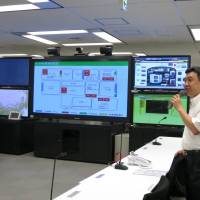The Nuclear Regulation Authority on Thursday showed the media its new Emergency Response Center, where data will be gathered and decisions made if another Fukushima-like disaster strikes.
The ERC, situated in the NRA building in Tokyo's Roppongi district, is nearly three times larger than the one used when the disaster hit and has two teleconferencing systems instead of one.
The previous ERC, which was run by the now-defunct Nuclear and Industrial Safety Agency in Kasumigaseki, only had one system, which limited its ability to get on top of the crisis. According to official findings from the Fukushima disaster, regulators were unable to determine what was happening at the plant in part because the ERC and Tokyo Electric Power Co.'s headquarters weren't able to teleconference.
The new ERC has two teleconferencing systems — one dedicated to the power plants and one to handling outside issues, such as evacuations.
The ERC can use the system to connect with nuclear power plants across the country, the municipal and prefectural governments hosting them, the utilities running them, and the prime minister's office.
The old ERC had only 250 sq. meters of floor space, but the new one has 700 sq. meters — enough to let 200 people work together instead of just over 50. During the Fukushima crisis, more than 100 people jammed the facility.
The center is divided into several sections by task, with some devoted to reactor analysis and others to radiation monitoring, medical assistance or public relations.
It also has systems for checking the status of all of the reactors in the nation, as well as SPEEDI (system for prediction of environmental emergency dose information), the simulator that projects how radioactive fallout ejected into the atmosphere will spread in case of a nuclear crisis.



















With your current subscription plan you can comment on stories. However, before writing your first comment, please create a display name in the Profile section of your subscriber account page.